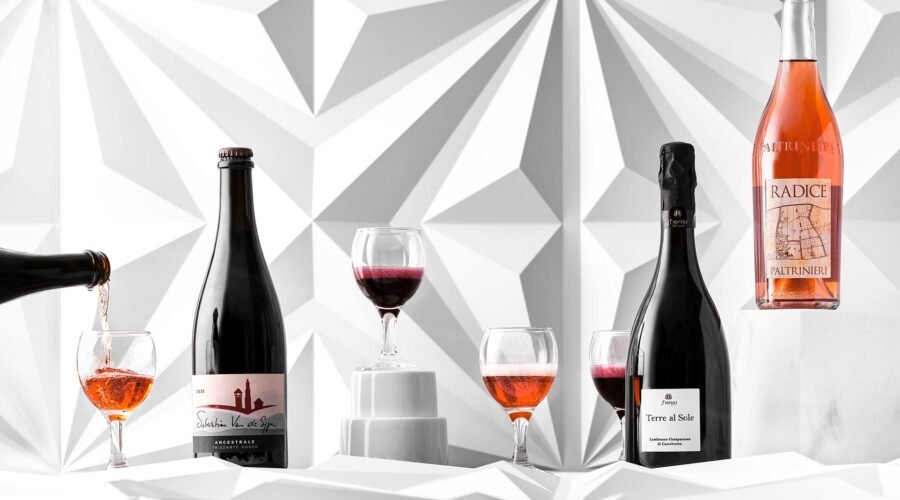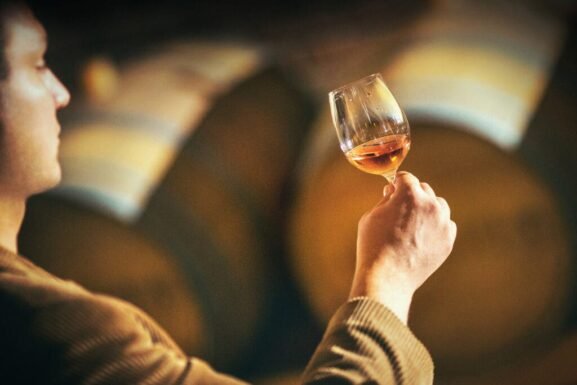Culture: Riding the Funky Sparkler Trend, Lambrusco Makes a Splash
Don’t call it a comeback—Lambrusco is the OG of alternative sparkling wine. The wild family of grapes known as Lambrusco, native to Emilia-Romagna and southern Lombardy, has been glorified by the likes of Virgil, Cato and Pliny the Elder, each highlighting the delicious and unique character of this boisterous family of different, but related, varietal types. There are references to early Romans fermenting the wine in amphorae—and we begin to see documentation of bottled sparkling wine made from the various Lambrusco grapes in the 1800s.
Today, thanks in part to the rise of pét-nat’s popularity, funky sparklers are becoming a trend—and Lambrusco has a 200-year head start. “Today’s iterations have more character and freshness than was commonplace in the past,” comments Femi Oyediran, co-owner of Graft in Charleston, South Carolina. But Lambrusco is still fighting its 1970s and ’80s reputation as a simple, fizzy, sweet red wine produced by large cooperatives and commodity producers.
In truth, there are many styles of Lambrusco—from bone dry to sweet, slightly fizzy to full-on bubbly, bright white to the inkiest purple in color.
Back in the ’70s and ’80s, those mass-producers of Lambrusco used the Charmat (tank) method to create their sweet, fizzy wines. The Charmat method is still used today, but more thoughtfully: “With Charmat you can recognize the purity of fruit of the variety, you preserve freshness and fruitiness, if made in a serious manner,” comments Alessandro Medici, the fifth generation of Medici Ermete. Lambrusco made in the Charmat method jumps out of the glass—they are forward and upfront about their fruitiness: sour cherries and pomegranate if using Sorbara; ripe and juicy black plums if made from Grasparossa. They are fun, inviting, delicious and easy wines, wines meant for the moment.
Prior to the introduction of Charmat, in the 1960s, producers of the region created bubbles either via the ancestral method or rifermentato. Today, the terms are used somewhat interchangeably but technically they are different. The ancestral method is one fermentation done in two parts. The producer will press the grapes, begin fermentation, but while it is still fermenting and has sugar, they bottle the wine and fermentation continues in bottle, trapping the CO2 and making bubbles. “This is making one of the most difficult wines in the world if you do not manage the wine correctly. It is not an easy project, but I believe in it,” says Sebastian Van de Sype, Lambrusco producer and former Formula One engineer.
Rifermentato, on the other hand, is seen as the more historic method of the region. “Traditionally…they kept a part of their must and in spring they would bottle the finished wine with a little of that must, which would promote the next fermentation, or rifermentato,” explains Master of Wine and Lambrusco enthusiast Gabriele Gorelli. But it wasn’t until the mid-1990s that small family farms began to reintroduce rifermentato around Modena and Parma, catching the attention of top restaurants, importers and, maybe more importantly, other producers within the Lambrusco production areas.
Wines made via rifermentato or ancestral method highlight the core of fruit found in the grapes of the Lambrusco family, but provide more nuance, specificity, depth and textural expression. The wine’s bubbles (or perlage) tend to be finer, the tannins more refined— you feel more of the wine. It is like the difference between playing Chopsticks versus Bach on the piano. There are just more notes.
A growing number of producers are making Lambrusco using the classic (or Champagne) method, with extended lees aging and a slightly higher pressure. This creates a wine with heightened secondary aromas of flowers, earth and even cured meat and produces very fine, persistent bubbles. Fabio Lini of Lini 910 is one of the pioneers in traditional method Lambrusco who began experimenting with the process in the 1970s due to his love of Champagne. After decades of work, the Lini family introduced a 100% Salamino Lambrusco made via the classic method and it was a smash hit. The family ages the wine on the lees for many years with the current vintage being 2007. As Alicia Lini describes it, it’s “a miracle in the Lambrusco world” to have a wine aged for 16 years in the bottle before release, but “this shows the passion and the enological capabilities behind Lambrusco.”
This push for quality and search for unique expressions of the Lambrusco family of grapes is only moving quality higher and giving the world what it wants. Each method used to achieve putting bubbles in the wine has its place, gives it its own personality, expression and purpose. The beauty of Lambrusco is in that diversity.
Interested in exploring the sparkling wines of Lambrusco? Here are some of our favorite bottles that highlight the region’s diverse winemaking techniques.
Wines Made Using Metodo Ancestrale
Wines Made Using Rifermentato
Paltrinieri “Radice” 2021 (Lambrusco di Sorbara)
When you get a wine like this, there is no turning back. A wine that is both pure, delicious and intriguing all at once is a rarity and is to be celebrated. At first, it is reserved. But once it wakes up, the wine shows a fresh mix of strawberry, boysenberry and pomegranate that gives way to intense floral notes, wild herbs and game. It’s energetic and vital with acidity that’s so crisp you will not realize you have just downed the bottle. 96 Points— J.P.
$24
Wine.com

Vigneto Saetti “Rosso Viola” 2021 (Lambrusco dell’Emilia)
100% Salamino grown organically in the hills north of Modena this wine is the personification of the Saetti family’s dedication to their craft. Aromas of blackberries, mulberries and tamarind share the glass with violets, dried roses and wild herbs. The palate is lush and vibrant at the same time with rich ripe black-hued fruits balanced with crunchy acidity. The wine has a long and refined finish highlighted by the well-crafted perlage. 95 Points—J.P.
$22
Wine.com

Podere Giardino Suoli Cataldi Rosso 2020 (Lambrusco dell’Emilia)
The Crotti family organically farms a little over 123 acres with only 12 acres devoted to vines. Their dedication to their craft shines in this stunning Lambrusco. Aromas of sour red cherries, fresh cola nut, savory spices and dried flowers waft from the glass. The core of the palate is a mix of sour plums and wildflowers with a touch of hoisin sauce on the finish. This is a serious and equally fun wine at the same time, but know that it shines best with some prosciutto, cheese or other savory snacks. 95 Points— J.P.
$ Varies
Wine-Searcher

Terrevive “Stiolorosso” Rosso (Emilia)
Established in 2008, Terrevive is not just a vine grower but also an integrated farm that creates biodiversity that makes healthier grapes and people. The Stiolorosso has aromas of blackberry, cherry and white pepper. The palate is mouthfilling and supremely structured, balanced between a deep core of black fruits and intriguing savory herbs and spice, finishing with crisp acidity and superfine bubbles. 96 Points— J.P.
$ Varies
Wine-Searcher
Wines Made Using Metodo Classico

Lini 910 “In Correggio” Rosso 2007 (Italy)
The Lini family has been at the forefront of producing Lambrusco via the Champagne method since the 1970s, and this wine shows their expertise. Aged for 14 to 15 years on the lees, this 100% Lambrusco di Salamino is radiant with ripe cherries mixed with savory herbs, sweet spices and blueberry tart aromas. The palate is rich yet light with an acidity that keeps the palate fresh. The wine finishes with complex notes of plums, dried herbs and violets. Drink now–2035. 94 Points— J.P.
$ Varies
Wine-Searcher
This article originally appeared in the August/September 2023 issue of Wine Enthusiast magazine. Click here to subscribe today!
Last Updated: July 14, 2023
Like what you’re reading? Learn more about:


